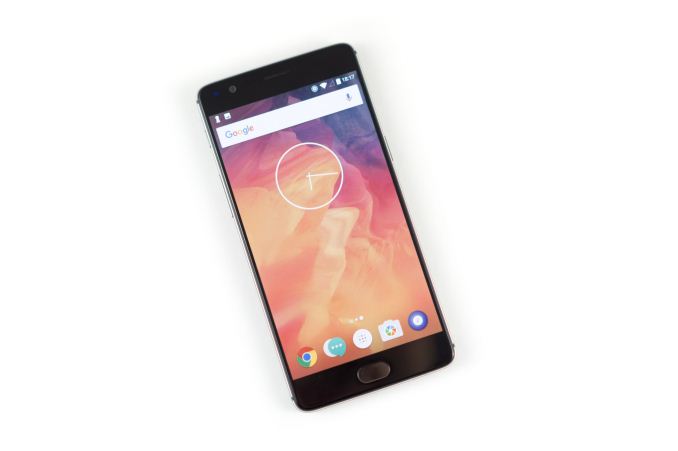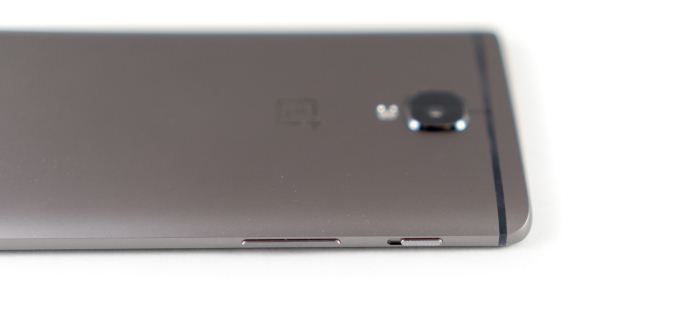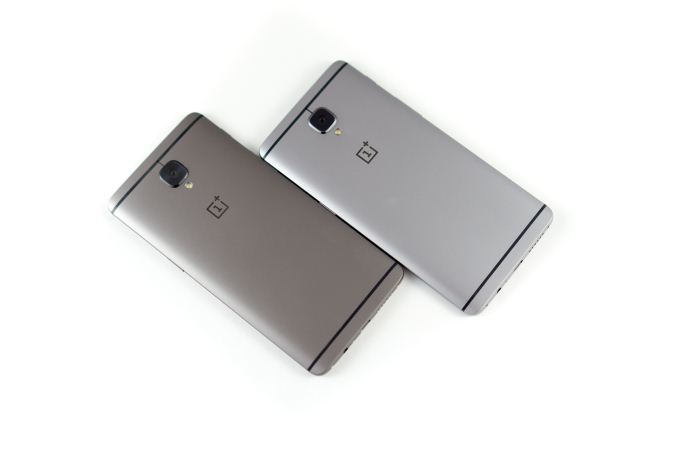The OnePlus 3T Review
by Brandon Chester on November 28, 2016 10:30 AM EST- Posted in
- Smartphones
- OnePlus
- OnePlus 3T

Back in June, OnePlus launched their new flagship smartphone, the OnePlus 3. I've had an interesting relationship with the OnePlus 3 due to certain decisions that were made regarding its display and some parts of the operating system before the phone initially launched. Since that time, OnePlus has made significant improvements to both of these aspects, and in my follow up piece I concluded that the OnePlus 3 should be considered by all smartphone buyers, even ones who were ready to pay $700 or $800 for a flagship phone from another company.
Earlier this month, OnePlus surprised a number of people in the Android community by launching a successor to the OnePlus 3. This move isn't in line with the yearly cadence that we've come to expect for their smartphones, which makes it all the more interesting. The name of this new phone is the OnePlus 3T, and based on that name one can already see that it represents an evolution of the OnePlus 3 rather than a revolutionary upgrade. As the OnePlus 3's successor, the OnePlus 3T simply serves to update certain aspects of the phone's hardware in order to take advantage of technology improvements that have been made available since the OnePlus 3 was originally developed and released.
This review focuses on the aspects of the OnePlus 3T that differ from its predecessor. Because of that, I recommend reading over my review of the OnePlus 3 if you're interested in other aspects of the phone like the camera quality. Before moving on, I've collected all the specifications for the OnePlus 3 and 3T in the chart below to make it clear which parts have changed and which have remained the same.
| OnePlus 3 | OnePlus 3T | ||
| SoC | Qualcomm Snapdragon 820 2 x 2.15GHz Kryo 2 x 1.6GHz Kryo 624MHz Adreno 530 |
Qualcomm Snapdragon 821 2 x 2.35GHz Kryo 2 x 1.6GHz Kryo 653MHz Adreno 530 |
|
| RAM | 6GB LPDDR4 | ||
| Display | 5.5" 1920 x 1080 PenTile AMOLED | ||
| Size / Mass | 152.7 x 74.7 x 7.35mm, 158g | ||
| Battery | 3000 mAh | 3400 mAh | |
| Rear Camera | 16MP 1.1 μm Sony IMX298, f/2.0, OIS | ||
| Front Camera | 8MP 1.4 μm Sony IMX179, f/2.0 |
16MP 1.0 µm Samsung S5K3P8, f/2.0 |
|
| Storage | 64GB UFS 2.0 | 64/128GB UFS 2.0 | |
| I/O | USB 2.0 Type-C connector, 3.5mm audio | ||
| Connectivity | 1x1 802.11a/b/g/n/ac + BT 4.2, USB-C, GPS/GNSS | ||
| Software | Android 6.0.1 OxygenOS 3.2.8 |
Android 6.0.1 OxygenOS 3.5.1 |
|
| Price | 64GB 399 USD |
64GB 439 USD 439 EUR 399 GBP 599 CAD |
128GB 479 USD 479 EUR 439 GBP 639 CAD |
For the most part, the OnePlus 3T is the same as the OnePlus 3. The size and mass are both the same, the display is the same, the rear-camera is the same, and the connectivity is the same. Internally OnePlus has made some changes to certain components. The most obvious change is the new SoC, with Snapdragon 820 being replaced with a faster Snapdragon 821 chip, while the RAM remains a healthy 6GB of LPDDR4. The battery capacity has also increased from 3000mAh to 3400mAh, which is a 13% increase without any change in the size or mass of the phone. The last major change is the new front-facing camera, which has moved from the 8MP 1.4µm Sony sensor on the OnePlus 3 to a 16MP 1.0µm Samsung sensor. In addition to the changes across all models, OnePlus has also introduced a 128GB SKU for users who need more storage. All of these changes also come at a higher price, with the 64GB model starting at $439, up from $399, and the 128GB model coming in at $479.
Design
As far as its design goes, the OnePlus 3T is mostly unchanged from its predecessor. I'm quite a fan of the OnePlus 3's design, so I don't feel that there was any need to change it significantly. The relatively thin body and the tapered back design make it far more usable with one hand than other 5.5" smartphones like the Pixel XL or the Moto G4. Being made from a single piece of aluminum, the chassis has none of the seams that the OnePlus One and OnePlus 2 had, and it feels incredibly solid in the hand. Unlike certain other vendors, OnePlus has also taken the time to actually align the various ports and buttons on the sides of the chassis instead of placing them wherever is convenient without any regard for aesthetics or usability.
Beyond the purely physical aspects of the design, I think OnePlus's design decisions regarding the placement of controls also makes the phone easier to use than competing devices. Having been using the OnePlus 3 since launch, I can say with certainty that OnePlus is on the right side of history by putting the volume rocker on the left side of the phone along with a physical switch for toggling notification settings. I also really appreciate having capacitive navigation buttons instead of wasting space on the display with on-screen buttons sitting above a bottom bezel that could easily fit physical ones. Putting the fingerprint scanner on the front of the phone as part of the home button also makes it simple to turn on and unlock the phone, even if it's sitting on a table.
The only aspect of the design that has changed from the OnePlus 3 is the color of the phone. The OnePlus 3 was originally available in a standard silver aluminum finish and later came in a gold finish, while the OnePlus 3T comes in a gunmetal grey finish and a gold finish from the start. The gold finish is only available in a 64GB capacity, while the gunmetal has both a 64GB and a 128GB version. For this review the 128GB gunmetal model was sampled, and I think it's a nice look for the phone. It's certainly not as dark as Apple's black iPhone 7 finish, but it's visibly darker than the OnePlus 3's aluminum and helps to distinguish between the two. I wouldn't have minded if OnePlus had also kept the standard silver finish available, as I think it looked rather nice as well, but I don't think the gunmetal is such a dramatic change in color that users will be bothered by silver being unavailable.












104 Comments
View All Comments
ithehappy - Tuesday, November 29, 2016 - link
I guess I am the lucky one but it has never happened to me. I used Note 2 for 10+ months, Note 3 for almost a year, S2 for 15 months, S4 for 9-10 months, and in none of them there was any sign of any sort of burn in. Now I know that Samsung uses the very best panels when its about their own flagship but still.zepi - Wednesday, November 30, 2016 - link
If you lose 10-20% of max brigtness and your color balance shifts a bit because one sub-pixel loses a fraction of more color than others, you will never see it with naked eye when the change happeng over 12-15 month-period.Actual burn-in... I don't know how easy it is to see that in regular phone. I've seen many samsung phones and tablets (tab s2) with severe burn-in, but those have been on display in stores where they run 24/7 screen in short loops and lots of static images.
ithehappy - Monday, November 28, 2016 - link
Well took a good 20 minutes to read the review in full, thanks a lot for upping this pretty fast.I am just so excited to see the sRGB mode got even more improved than before, that is excellent. Though like you mentioned 1080p Pentile is not particularly good, especially for text rendering.
The camera, that was the main thing they could have changed, I mean the OP3's camera performance isn't really good to my eyes, so they could have tweaked it a bit or something, rather than changing something as stupid as the selfie camera, jeez!
I am still torn between this and Pixel though, damn it.
PS: There is a small typo there by the way, when you said, "The display is essentially the same, although in my case I did see an even higher level of accuracy in the sRGB mode than I did on the OnePlus 3T...."
I am sure you meant OnePlus 3 there.
ikjadoon - Monday, November 28, 2016 - link
"However, it's important to recognize why this is, particularly where write speeds are concerned. Most smartphones we review have either 16GB or 32GB of internal memory. The OnePlus 3 has 64GB, and this OnePlus 3T unit is the flagship 128GB model."Maybe one way to alleviate this issue and to have better informed readers (most of us have read SSD reviews here) is to list the device's capacity in the chart? So that when we compare the speeds, we know we're comparing apples-to-apples, at least in terms of capacity?
mobutu - Monday, November 28, 2016 - link
40bucks for 10-15% more battery life? I'm game.ahtoh - Monday, November 28, 2016 - link
How is the camera?Mikad - Tuesday, November 29, 2016 - link
The camera in on level with Lumia 920. I've changed my phone from Lumia 920 -> LG G3 -> Lumia 950XL -> Nexus 5x -> OnePlus 3 and unfortunately OP3's camera ranks the lowest, equaling 920.In every other way OP3 is the best phone I've used but the camera is a big let down. Especially compared to the 950XL and Nexus 5x.
You can get good pictures if everything is still. But if there is even little movement happening, the pictures are blurry.
solnyshok - Tuesday, November 29, 2016 - link
I am in the market for a new phone. Op3T is good, but S7 Edge 64gb has dropped to 500 Euro in my country. Camera and display are significantly better, CPU perf is on par, and battery life is epic. Considering small price difference, I will probably take S7 Edge.solnyshok - Tuesday, November 29, 2016 - link
oops, I meant 32gb variant. Still, with microsd slot, it is good enough10basetom - Tuesday, November 29, 2016 - link
I've read that they also upgraded the rear lens to Sapphire, which is added to the cost as well.